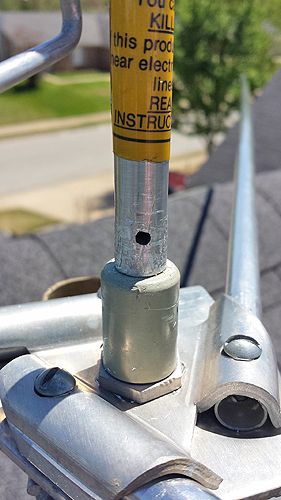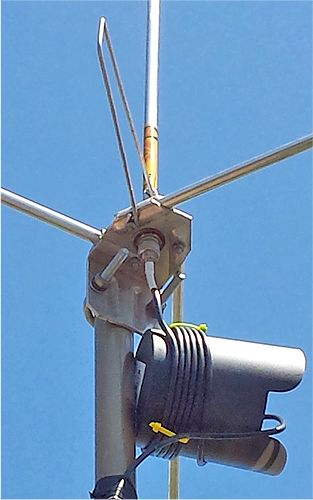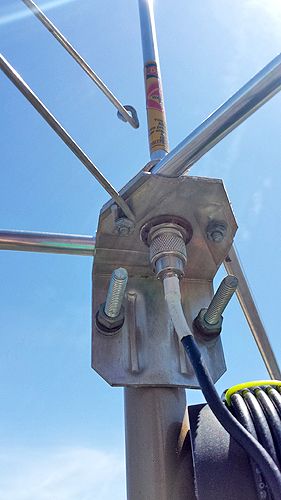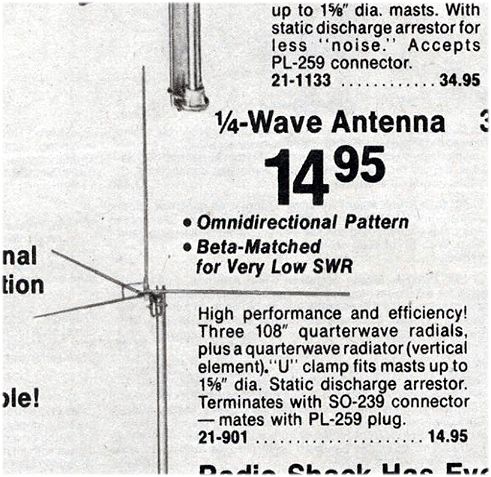Sorry about that I thought about that after I hit the enter button I wasn't sure about the radials an to lazy to click back an look at your pic , hence the mistake . Oh well back to research if I get bored again !But MFJ uses that type of clip in their design or was that common then ? I wonder if they made it ?
You are using an out of date browser. It may not display this or other websites correctly.
You should upgrade or use an alternative browser.
You should upgrade or use an alternative browser.
-
You can now help support WorldwideDX when you shop on Amazon at no additional cost to you! Simply follow this Shop on Amazon link first and a portion of any purchase is sent to WorldwideDX to help with site costs.
My Guess is It's An Antenna Specialists
- Thread starter HomerBB
- Start date
I know the impedance is higher on a 1/4 wave GP if the radials are horizontal. I figured this resolved that issue.
the impedance is actually lower on a 1/4 wave gp with horizontal radials.
at 180 degree, a dipole, its nominally 72 ohms, at 90 degree its nominally 36 ohms, at 135 degrees its 54 ohms,
starduster is just under 135 degrees to give a direct 50 ohms/ 1.0:1 vswr. ideal for direct feeding with coax and no lossy coil.
not only is impedance lower at horizontal 90 degrees 50/36 = 1.39:1 rounded up. at dipole 180 degrees its 72/50 = 1.44:1,
as you can see horizontal radials also give a slightly lower vswr too, granted its not much, but it is lower, not higher and therefore a better match than a dipole and slightly more efficient, although that's probably immeasurable in use and real world conditions
i'm curious, does centre pin of coax show DC continuity with radiator, as matching loop may well be to cancel out capacitive reactance if its capacitively fed inside the base, cause if its not it looks like radiator is directly attached to ground, just a notion cause the sirio tornado 27 looks to be fed that way too. I may be wrong as I've never seen that antenna before.
Hey, jazz, thanks for correcting my goof.
When I get a chance I'll lower it and check the antenna more closely. However, I think the vertical radiator is nothing more than a tube, no capacitor, inductor, nor anything ay all. I'll loosen the loop from it and unscrew it for a photo.
When I get a chance I'll lower it and check the antenna more closely. However, I think the vertical radiator is nothing more than a tube, no capacitor, inductor, nor anything ay all. I'll loosen the loop from it and unscrew it for a photo.
imho it looks like a dollar match idea to raise the feed-point impedance at resonance to 50ohm by shortening the radiator to add capacitive reactance and shunting the feedpoint with a corresponding inductance, dc ground is a bonus.
That's also a possibility Bob but going by the stated 107" I assumed the capacitor was in the base, centre pin feeding an internal smaller tube separated from radiator by a surrounding dielectric, similar to an internal gamma match.
but it could be either without closer inspection. why anyone would go to the hassle just to get a perfect 1.0:1 vswr is beyond me, its no biggie a vswr of around 1.4:1 and they are generally damn fine antennas and highly underrated like the starduster m400
the antenna warning label looks very similar to my old antenna specialists mighty magnum 3, so could be A/S, but could just be a standard sticker many companies use.
its deffo an inductor/hairpin grounded at one end so there will be capacitance either where i suggested or where Bob has suggested, as long as swr is good, ie below 2.5:1 it will work and work well, have no doubt about that Homer, i wouldn't worry about the goof mate, at least now you know how to work out expected vswr from feed impedance. you always divide the larger number by the smaller one to get the ratio
On a separate note for those interested or with radios/swr meters you may think are misreading:
A handy wee tip if you want to calibrate an analyser or swr meter is get a T junction and two identical parallel resistive dummy loads, swr should be 2.0:1 as paralleling them will give half of one of their individual resistances, or 25 ohms, may be 27.5 if both are 55 ohm, which is common on a cheap dummy load.
you can measure true resistive value of dummy load with a multimeter on centre and outer pin set to a low ohms range, 100 or 1000 range is ideal, might be 200 and 2000 on some meters as long as its over 50 your sorted.
if you can find a 3 way splitter 3 x 50 ohm dummy loads will give a 3.0:1 vswr and 0 reactance and should show around 17 ohms resistance, will be 16. something as the values on either side are purely resistive.
Cheap and cheerful trick that works for external swr meters, built in ones or even analysers if you know the presets that calibrate it.
the exact same thing is done with a cophase harness, except instead of two 50 ohm dummy loads, the antenna swr is inverted to 100 ohms by q section on either side then paralleled to give the required 50 ohms which is half of one 100 ohm side. if they were added in series they'd show 200 ohms as they would combine impedances.
2 identical resistors give half the value of one of their values,3 1/3 value, 4 1/4 value, 10 1/10th value and so on, but only works for equal resistors, there's a slightly different formula for unequal resistances. If you want to learn that, google resistances in parallel.
its how many dummy loads are made, 20 x 1000 ohm resistors in parallel give 50 ohms, 1/20th of an individual one, but they will handle 20w if 1w resistors, 40w if 2w resistors and so on,wattage handling is the number of resistors times their power handling/dissipation, you can build a dummy load to handle just about any power level or impedance/resistance this way, often oil is added to cool them or they are air blown to allow slightly higher power briefly, 1% tolerance resistors are best for this job but could use higher percentages and just measure them to find ones that are either the exact same or very very close, all the exact same gives most accurate results
It definitely doesn't look like there is room to put a capacitor inside, and even if they did have one that small in there it would be so small that it would severely limit the power handling capabilities of the antenna next to the nearly unlimited power within reason not having such a capacitor would have. Besides, this type of match is typically meant to be used with the capacitive load of a slightly shorter antenna anyway.
But I agree, unless your trying to prove a point there is no noticeable benefit to having said match for this antenna in the first place. That being said, many in the CB hobby think that anything other than a perfect SWR match will kill them, or at least their radio. This may have simply been a way to keep the masses that worship SWR as a god happy...
The DB
But I agree, unless your trying to prove a point there is no noticeable benefit to having said match for this antenna in the first place. That being said, many in the CB hobby think that anything other than a perfect SWR match will kill them, or at least their radio. This may have simply been a way to keep the masses that worship SWR as a god happy...
The DB
I attempted to remove the vertical for closer inspection. I did not. It is pressed onto the stud that is upward from the Pl connector. However, I could view through the screw hole for the hairpin, and the weep hole to let out moisture on the opposite side from the hairpin screw hole. There is no sleeve nor any wire, etc in the lowest part of the vertical.
I provided additional photos of the lowest section for possible clarity.The upper end of the matcher is loose in photos 1 & 3 is disconnected from the radiator.



I provided additional photos of the lowest section for possible clarity.The upper end of the matcher is loose in photos 1 & 3 is disconnected from the radiator.



I'm with 357Magnum. I had one of these antennas in 1978 and paid about 15 bucks for it with my 8th grade graduation money. Boy, am I gettin' old!
1978 Radio Shack Catalog On page 154... sorry the link didn't post direct.
Looks different than in Marconi's link, and you can see the hairpin in this one.
73,
Brett
1978 Radio Shack Catalog On page 154... sorry the link didn't post direct.
Looks different than in Marconi's link, and you can see the hairpin in this one.
73,
Brett
Last edited:
Thanks, Brett.

It seems likely although my radials and vertical radiator are shorter by 4". Someone must have altered it for resonance in freeband above 40.

It seems likely although my radials and vertical radiator are shorter by 4". Someone must have altered it for resonance in freeband above 40.
the one i have in my pile has been shortened for 10 meters which when i did have in the air i used it for ssb 10meter work,,, right now though i am going to use the radials on a starduster i am working on.....
Thanks, Brett.

It seems likely although my radials and vertical radiator are shorter by 4". Someone must have altered it for resonance in freeband above 40.
Homer, the matcher for this 21-901 is more like I might have expected for a 1/4 wave GP with H radials and a matcher. I can only guess, but this might be pretty much like the dollar match idea that Bob described to us above.
I still can't get this new look to produce a perfect match using Eznec, no matter whether I use your 104" inch dimensions or I make it 108" inches... as noted in these catalogs.
The 104" dimension does show resonance, but the resistive part of the match still is showing a value of R=25 ohms. So far nothing I do to the model will raise the value of R closer to 50 ohms...unless of course I slant the radials down. That could be a good option to consider. I just don't have many options to change the tap point to where 50 ohms might exist.
This said however, the gain for this one is not as good as my Marconi X antenna shows or my Starduster at the same height over average Earth. I'm not suggesting the difference is a big deal either, because I don't think we could see the difference just using our radios.
On the other hand, and compared to the earlier model that looks like your antenna...I see the pattern for this 21-901 styled matcher producing an improved pattern with a maximum lobe near the horizon. It also has a broad rage of the lobe from 10* degrees up to 28* degrees showing maximum gain. There is little to no dip across this range and for me that is a plus.
IMO this pattern is somewhat similar to the unique pattern I see with my AstroPlane models. The only difference between these RS models and my A/P is the high angle portion of the A/P models shows little to no high angle lobe in the pattern. The maximum power looks to all be pushed out toward the horizon and that to me is about as good as it gets.
If this is a true result for the A/P it may suggest a possible reason you and I see it perform so well...just my opinion. Personally I consider this look to be beneficial in a pattern.
I'll keep trying to see if I can improve the match by fiddling with this wire, but thus far I only see it tuning the reactance like inductors are prone to do. Right now this new model is showing J=+0.1139 ohms of reactance and thus I see resonance.
Last edited:
I can sleep tonight , I think we found it ! lol
Sent from my NB09 using Tapatalk
357, I will still be tossin' and turnin'.
I can understand this antenna may have been modified and cut for 10 meters, but in such a case why on Earth would anybody go to the trouble to cut the aluminum elements if they just wanted to make the elements a bit shorter. Taper should take care of any adjustment necessary to reach resonance from 11 meter to 10 meters.
Homer has also told me that his antenna may allow for no more than a 1" increase in element length. My model also finds resonance possible using Homer's dimensions. I see the RS ads showing 108" elements, and I know back then CB antennas were cut a little longer...and that may have been in part due to better resonance near the center of the 23 channel spread in radios back then. I'm not saying this is what happened, I just don't see a plausible reason for cutting this antenna just to get to 10 meters unless the elements were not tapered.
Sorry, but I still don't think we have identified what Homer has, plus his setup does not look anything like this most current catalog image. Me thinks this is just another view of another old antenna.
This is a good discussion however. We probably never would have seen such old relics...if Homer had not posted his new find.
dxChat
- No one is chatting at the moment.
